 |
||
|
||
| ||
Wide spreading of multifunctional OS on the x86 platform gave a possibility to increase intensively performance of the computation systems of this architecture: with a simple increase of processors in quantity in the system. Intel, having developed and pantented the SMP realization on their own platform, started developing a new chipset. The first one was i430HX, also known as Triton II. From that time practically all manufacturers might produce inexpensive dual-processor computers. Moreover, such configuration is acceptable even in case of home assembling. But powerful systems with more than ten processors required (like in the case of the processors of the previous generation, e.g. i486) special architectural solutions; for the majority of tasks they are superfluous, unlike relatively cheap dual-CPU machines. Many users of work stations have appreciated new possibilities, but they still unsatisfied with the performance gain. And it was due to low scalability of any CISC-architectures and, in particular x86. In order to get a significant increase in performance - apart from two processors and appropriate OS (Windows NT, OS/2 Warp Server, different UNIX-systems, Novell Netware) it was necessary to have an optimization of applications counting on multiprocessor feature. In the vast majority of cases a work station is not a multitask system (unlike servers). The number of processes is low and limited, even one processor never loads completely, that's why OS is not able to divide tasks among processors, and application optimization for SMP is a paramount problem. Intel, when releasing their first multiprocessor chipset, faced the same competitors in the chipset production field as now: ALI, VIA and SIS. But to none of these companies the license for SMP was sold, that's why in this market sector Intel possessed exclusive rights. Though I should correct myself: some companies (such as Micron, IBM, DEC, AMI, ALR) received a license and had their own goodies in this field, but they had no right both to deliver the license to somebody, and to give out their chipsets to the third parties. AMD representatives, with the release of K6 processor, announced a potential possibility of its operating in multiprocessor configurations, but it got failed because of the license limitations. The first chipset not from Intel which could be shipped to anybody and which supported SMP was Aladdin Pro II from ALI, however, like the i440LX/BX, it supported two CPUs only with an additional chip provided. Intel reacted adequately - shipping of these chips to motherboard manufacturers would mean a withdrawal of license from ALI for chipset production for Intel processor forever. Nevertheless, a practice of cross licensing played with Intel a spiteful joke - VIA concluded an agreement with the greatest semiconductor manufacturer in the USA - National Semiconductor (their logo can be seen on any chip from VIA). National Semiconductor was never interested in processor wars, that's why Intel didn't worry about the cross-license with that company, but that was wrong… VIA had received a license access to all processor developing works of Intel, and the latter didn't risk to start legal proceedings with National Semiconductor. so, Intel lost its last exclusive right - for the production of budget SMP-chipsets (Serverworks, which is easily selling their own chipsets, does not position them on the market of inexpensive high-efficient work stations). VIA gave out a response quickly - in April of the last year they announced a support for two CPUs by VIA Apollo Pro 133A chipset. So, the epoch of unlimited ruling of Intel chipsets, starting with a release of rather successful Triton, is coming to end. Today, the huge majority of manufacturers offer dual-processor boards on a VIA chipset. Interestingly that Tyan - one of the leaders in shipping of the boards for servers and work stations to the retail market - became a pioneer. ParticipantsToday we have 5 boards in question: Abit VP6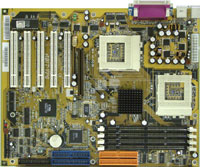 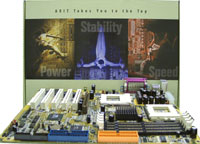 A well-designed yellow-brown board with a legacy RAID-controller from HPT. Despite sound features support by 686B south bridge, the board lacks for AC'97-codec. As for some downsides, I can mark only rather big dimensions and periphery position of the main IDE connectors, but only one dual-processor board on the Apollo133A can be called little - Q-Lity CPV4-TD, that's why Abit is not guilty. Presence of additional USB-panel and UATA-cable is a pleasant feature of all modern boards from this company. And this is not surprising: Abit works only for the Retail-market, and thus, only for an end-user. Elitegroup D6VAA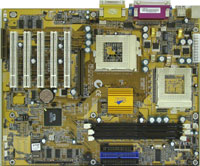  This board just slightly differs from PC Chips M790MR in layout: Elitegroup is already one and half a year a department of the greatest motherboard manufacturer HsingTech, "famed" with its trade mark PC Chips (and some others). Nevertheless, there are some differences: M790MR can be produced also in MicroATX format and has no an optional possibility of installation of an external ATA100-controller. In fact, the sample of Elitegroup which I had, also lacked for ATA100, but it had a place for the HPT370 chip and two additional IDE connectors. Like all other boards, this one supports CPU VIA Cyrix III, but interestingly that its installation is done without any change in position of jumpers - in a uniprocessor configuration the first socket is used for Intel, and the second - for VIA. Downsides are the same as in the Abit board. On the other hand, I think it makes no sense to use cheap small cases for dual-processor boards. EPoX EP-D3VA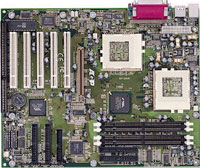 A young (for Taiwane) manufacturer of EPoX motherboards is well-known for high quality design and perfect bonding. For example, only one board series on the VIA Apollo MVP3 can work correctly with TV-tuners on the BrookTree/Conexant chips, and these boards are produced exactly by EPoX. Peripheral position of IDE-connectors of the main controller doesn't prevent installation of the board due to small dimensions. However, a bit too close location of the first connector of the main disc controller to the fourth DIMM slot makes no good, but it's unlikely that you would have to install memory in the last slot. Usage of the outdated 596B south bridge, which lacks for a controllers of the peripheral ports, keyboard and thermo control, is compensated by the corresponding external chips. As for control of temperature, voltages and fan rotation this solution is positive - standard possibilities of the VIA south bridges are limited (ASUS, for example, uses additional chips even on the boards with 686A, where it is necessary). Iwill DVD266-R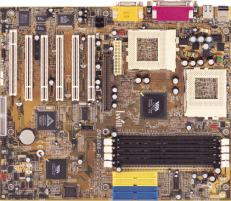 The layout of the board is not that good, on the both available revisions (0.9 and 1.0). The both variants are engineering samples (0.9 whose photo is above, and 1.0 which is traditionally green). Power connector located between a processor socket and AGP slot surprised me a lot. It's still good that I used ADDA fans of standard dimensions, and not the ORBs which could cause some troubles. Huge dimensions together with peripheral position of the main IDE-connectors and a single capacitor is a weight on my mind. Location of the floppy-connector on the edge of the board behind the ACR-slot is just awful. The KK266-R board lying in front of me has, however, a good layout. But I think that every product of a respected company that sells their products at rather expensive price must be above all! The only thing that can reassure you is that all these are pre-release variants. The VIA VT8233 south bridge lacks for controllers of peripheral ports, that's why there is used an external chips from Winbond. The Iwill board is the only that is equipped with a full-value sound controller from Cmedia - a department of the powerful Hsing Tech, what arises some thoughts (relations between Elitegroup and PCChips started from a decent installation of Cmedia 8330 sound chips on the ECS boards). On the other hand, though, these chips are also installed by Asus and Chaintech on their boards. The chipset is realized according to the single scheme (without deletion of a codec and the chip), but it is too cheap and allows to equip it with full-value sound without lifting the prime cost. MicroStar 694D Pro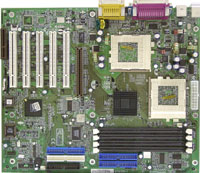 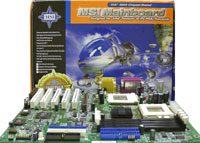 MicroStar, which is one of the three leaders of Taiwanese motherboard manufacturers, seems to be aimed at confusing users:
But in price-lists all are named "MSI 694D Pro". Besides, any of the boards instead of the CNR-connector can have ISA slot. I had an outdated 6321 sample with 686A south bridge (today 686B is installed) and RAID-controller from Promise. The layout is rather good: the main IDE-connectors are a bit far from the edge but are too close to the fourth DIMM slot, a power connector is on the edge. In my opinion, though, in all boards with AMR/CNR/ACR-connector the latter should be put between AGP and the first PCI slot. It's connected with the fact that some AGP-adapters have huge heatsinks with fans, what in case of too short distance doesn't let us to install any board in the first PCI. A communication slot between AGP and PCI usually solves this problem. Now you can look at their characteristics in a single table:
Comments:
Iwill DVD266-R board or
|
||||||||||||||||||||||||||||||||||||||||||||||||||||||||||||||||||||||||||||||||||||||||||||||||||||||||||||||||||||||||||||||||||||||||||||||||||||||||||||||||||||||||||||||||||||||||||||||||||||||||||||||||||
| VCore1, V | VCore2, V | |
| Elitegroup D6VAA |
1.69
|
1.63
|
| Abit VP6 |
1.68
|
1.37!!!
|
| EPoX EP-D3VA |
1.71
|
1.66
|
| MSI 694D Pro |
1.69
|
1.69
|
| Iwill DVD266-R |
1.68
|
1.52!!!
|
Because of impossibility to control VCore in a dual-processor configuration, testing of the Abit and Iwill boards (on the whole, the latter worked good, but it refused to pass some tests from synthetical packets; in case of installation of equal processors the problems disappeared) were done with two CPUs from one series (SL464 with the rated 1.65 VCore).
Besides, I tested the EPoX board with processors both with different stepping and with the same one - we didn't notice any difference in performance.
Applications used for tests:
| Real CPU frequency | |||||
| Elitegroup D6VAA | Iwill DVD266-R | Abit VP6 | EPoX EP-D3VA | MSI 694D Pro | |
| Real FSB Clock, MHz |
803
|
797
|
798
|
802
|
798
|

Some lag of the Iwill board in the "record to memory" mode is mainly connected with the fact that in testing was used not a serial sample, but an engineering one.
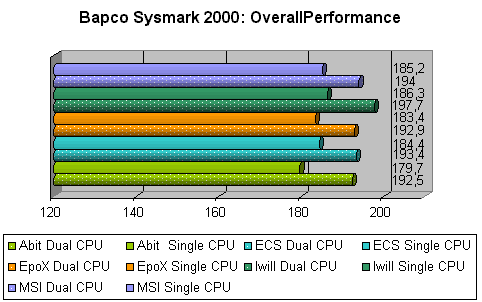

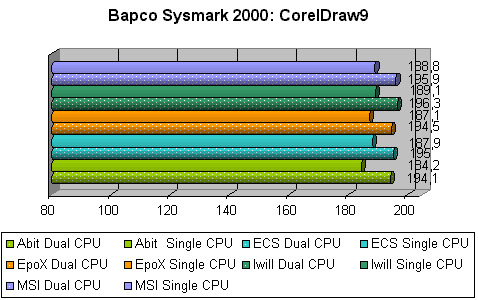
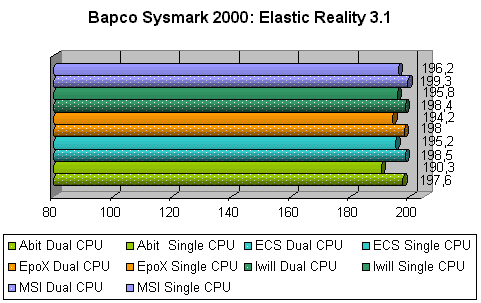
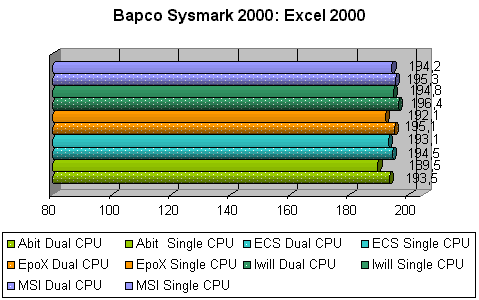
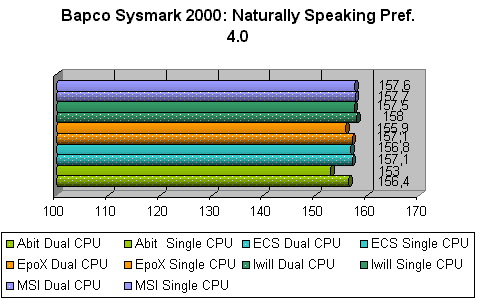
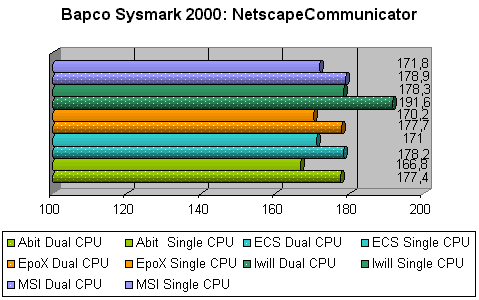
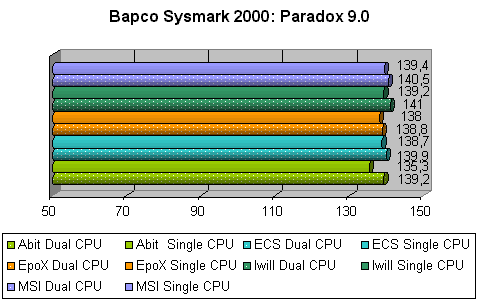
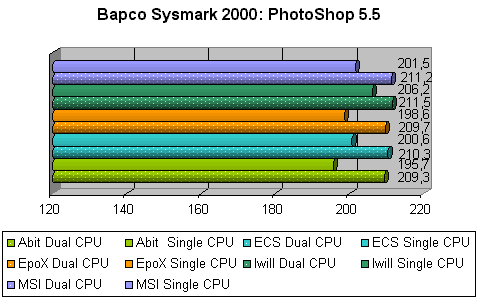
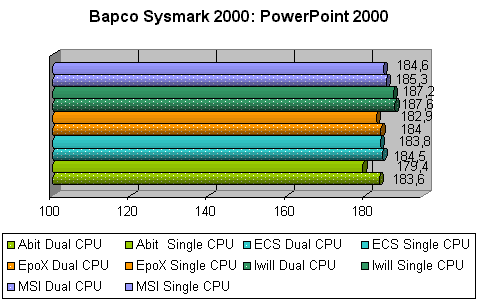
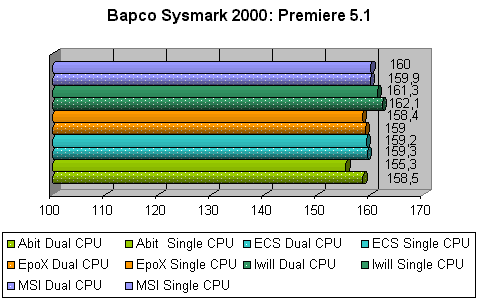
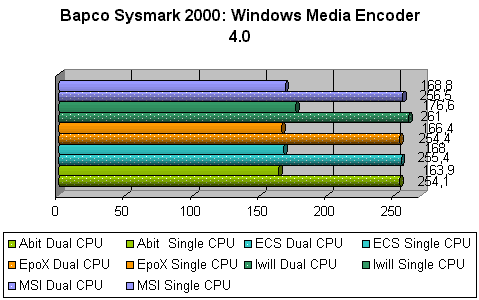
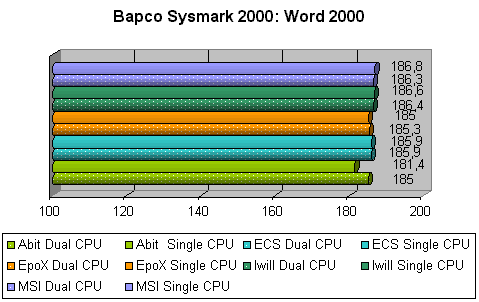
This test was carried out on each board 5-7 times, after that we calculated the geometrical mean. The relative error of the test is 1.5% (for the Content Creation Winstone 2000 the error was more than 2.5%, what brings to nought the sense of testing of the boards with similar performance). The Iwill board doesn't show a considerable gain (at least, it doesn't correspond to the difference in memory price). Note that the Abit board in a uniprocessor configuration lags behind the competitors by a great margin, and in dual-processor it is practically equal. A noticeable performance increase was achieved only in coding of audio-file (see the diagram), in other applications the increase from SMP is either minimal or absent at all.
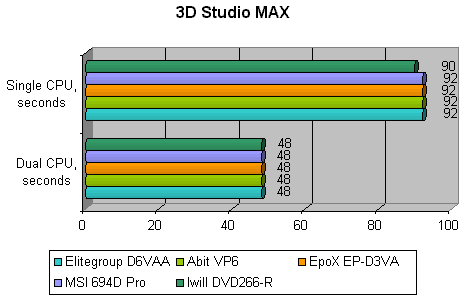
Testing in 3DS packet came down to rendering of "an anisotropic wheel", a scene included in the standard complete set - the most popular scene in performance testing.
A perfect gain in case of SMP usage proves a developed optimization for multiprocessor configuration. As for performance increase of the Iwill board, it is again minimal.
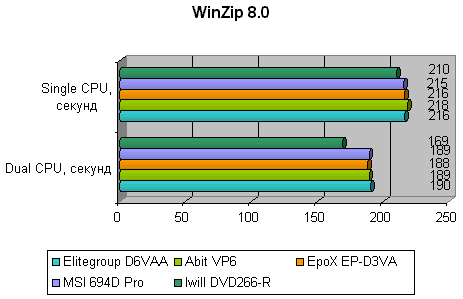
With the WinZip 8.0 we archived a .MOV file, 580 MBytes in size in the "best compression" mode. There is some increase. Traditionally, archiving requires a lot of processor time, here we can see exactly the OS dividing tasks among processors, on an optimized but a "hard" application. And usage of a board with DDR yielded little.
MP3-coder Go-Go has an optimization for 3D Now!, SSE, SSE2 and SMP. We implemented packing of a .WAV-file (44.1 KHz, 16 bit) 31 minutes long (350 MB) into 320 Kbps MP3-file.
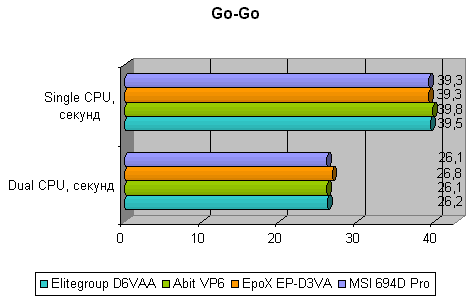
No comments.
Results of the Iwill are absent because of incorrect work of the program with this board (the results are 8-10 times worse than of the others).
MPEG2 coding results were taken from Video2000 packet.
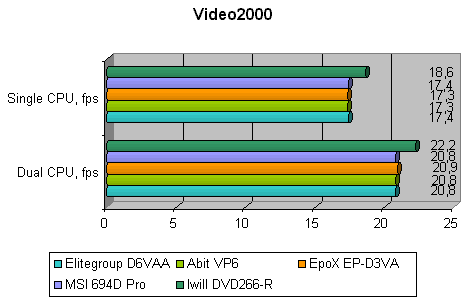
20% performance, or 1/5 computer time… Isn't it too little?..
DVD decoding is one of those tasks that induce users to lift performance of home systems. That's why, apart from packing of different files, I decided to show you these results as well. (VGA Speed Benchmark shipped together with DVD-player from CyberLink gives such opportunity). Normal YUY2 mode was used.
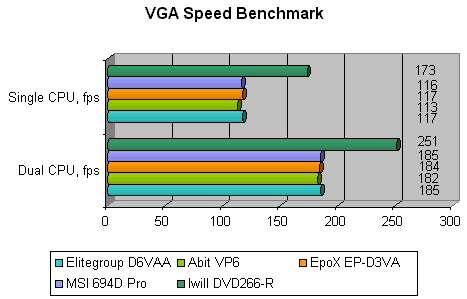
Well, high increase in case of SMP usage, and the highest with DDR SDRAM... I was surprised at such efficiency gain of the Iwill board.
You might know that SMP didn't give a high performance gain in Quake III. Each of you can calculate how much it will be beneficial to purchase a powerful computer, a video adapter, additional memory etc. instead of a dual-processor board and the second CPU.
This concerns practically all productivity results of multiprocessor systems based on the x86 and GTL+. Now we are waiting for a response from AMD 760MP.
First I want to consider overclocking - all boards feature rather huge possibilities in this field, but when building a work station, stability is a chief thing (then a couple of percents in performance over). If a rendering of some giant scene in 3DS can take several hours, with intensive loading both processors and memory, then I think that it's much better not to get a system failure a minute before the end than to gain ten minutes. That's why I didn't consider this aspect of boards' operation.
In general, boards showed that with intensive load and in a specially optimized applications you can get some (sometimes significant) performance gain, but today's situation with price for CPUs - when the price for each MHz slumps with increase in frequency, when there is much cheaper and not less efficient systems based on the AMD CPUs - doesn't leave a chance to multiprocessor systems to settle in the house of an end-user. The destiny of SMP systems now is servers and specialized work stations, preferably those which use optimized applications.
It's hard to mark out some card - their performance is very similar. Nevertheless, I'd like to stress the following:
Fans of this manufacturer can sleep quietly - a high quality board with a good performance level (only uniprocessor mode made a mess). No unfavorable criticism, only a bit too price.
Everything in this board is good, especially absence of ATA100 RAID (I'm ready to overpay in order to get an external Promise, AMI or SCSI-controller). Nevertheless, even with it the board's price is minimal among the contestants. My choice.
Very similar to the Abit, but much faster, more compact and is pleasantly green :) And the main thing its cheaper price (the difference between these boards exceeds a decent 64 MBytes memory).
Relatively high price is compensated by presence of RAID-controller from Promise and the highest performance. In general, it's the best among the equal.
This board deserves to pay attention to, but the
purchase can have a sense only with considerable price decrease
for DDR SDRAM.
Write a comment below. No registration needed!
|
Article navigation: |
| blog comments powered by Disqus |
| Most Popular Reviews | More RSS |
 |
Comparing old, cheap solutions from AMD with new, budget offerings from Intel.
February 1, 2013 · Processor Roundups |
 |
Inno3D GeForce GTX 670 iChill, Inno3D GeForce GTX 660 Ti Graphics Cards A couple of mid-range adapters with original cooling systems.
January 30, 2013 · Video cards: NVIDIA GPUs |
 |
Creative Sound Blaster X-Fi Surround 5.1 An external X-Fi solution in tests.
September 9, 2008 · Sound Cards |
 |
The first worthwhile Piledriver CPU.
September 11, 2012 · Processors: AMD |
 |
Consumed Power, Energy Consumption: Ivy Bridge vs. Sandy Bridge Trying out the new method.
September 18, 2012 · Processors: Intel |
| Latest Reviews | More RSS |
 |
Retested all graphics cards with the new drivers.
Oct 18, 2013 · 3Digests
|
 |
Added new benchmarks: BioShock Infinite and Metro: Last Light.
Sep 06, 2013 · 3Digests
|
 |
Added the test results of NVIDIA GeForce GTX 760 and AMD Radeon HD 7730.
Aug 05, 2013 · 3Digests
|
 |
Gainward GeForce GTX 650 Ti BOOST 2GB Golden Sample Graphics Card An excellent hybrid of GeForce GTX 650 Ti and GeForce GTX 660.
Jun 24, 2013 · Video cards: NVIDIA GPUs
|
 |
Added the test results of NVIDIA GeForce GTX 770/780.
Jun 03, 2013 · 3Digests
|
| Latest News | More RSS |
Platform · Video · Multimedia · Mobile · Other || About us & Privacy policy · Twitter · Facebook
Copyright © Byrds Research & Publishing, Ltd., 1997–2011. All rights reserved.